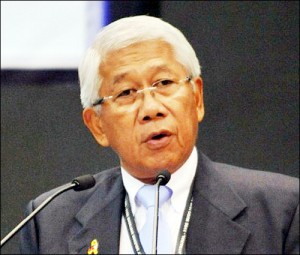Chinese fishing vessels have not left the lagoon of Scarborough Shoal and Chinese government ships continue to patrol the vicinity of the disputed, resource-rich area in the West Philippine Sea (South China Sea).
On Monday afternoon, after Foreign Secretary Albert del Rosario announced that there were no more Chinese fishing boats in the shoal’s lagoon, a Philippine Navy reconnaissance plane sighted 23 Chinese fishing boats—six large vessels and 17 dinghies—in the lagoon.
The Navy plane also spotted five large Chinese government ships—three China Maritime Surveillance ships and two Fisheries Law Enforcement Command ships—outside the lagoon.
The Philippines had no vessels in the area to assert its sovereignty over the shoal. President Benigno Aquino ordered a Philippine Coast Guard patrol vessel and a Bureau of Fisheries and Aquatic Resources (BFAR) survey ship home on the night of June 15, citing bad weather.
Speaking at a news conference on Tuesday, Defense Secretary Voltaire Gazmin and the Philippine Navy chief, Vice Admiral Alexander Pama, reported the presence of Chinese vessels at Scarborough Shoal.
Pama said a Navy Islander aircraft was ordered to fly over the shoal on Monday afternoon to verify if China had withdrawn its fishing boats from the shoal’s lagoon.
They come and go
He said the Chinese fishing vessels and maritime ships came and went, apparently taking turns in some kind of rotation.
Pama said the statement of the Department of Foreign Affairs (DFA) about China pulling its fishing boats out of Scarborough Shoal’s lagoon may have been based on “previous reports.”
A DFA statement issued on Monday quoted Del Rosario as saying, “Based on coordination between the Philippines and China, as of two days ago, we have received information that all (Chinese fishing boats) have left the lagoon of Bajo de Masinloc.”
The Philippines refers to Scarborough Shoal as Bajo de Masinloc and Panatag Shoal. China calls the area Huangyan Island.
When asked about the DFA statement, Gazmin replied: “We don’t want to react to that but what we are giving you is the factual operational report.”
DFA recommendations
The DFA on Tuesday said that it had forwarded recommendations to Malacañang, but department spokesperson Raul Hernandez would not disclose what the recommendations were.
“Let’s just wait for the decision of higher authorities,” Hernandez said in a phone interview.
“Two days ago, the Navy confirmed that the same fishing boats had pulled out of the shoal’s lagoon,” he said. “The Chinese fishing boats have obviously returned.”
Citing a Navy report, Hernandez said that as of Monday afternoon, there were five Chinese government vessels outside the shoal’s lagoon and six fishing boats and 17 dinghies inside the lagoon.
The Philippine Daily Inquirer tried but failed to reach Zhang Hua, the spokesperson of the Chinese Embassy, for comment.
Who’s in charge?
After hearing that Chinese fishing boats were still at the shoal, Muntinlupa Representative Rodolfo Biazon said the government should be wary of negotiating with a Chinese government that appeared to be “speaking in two voices.”
“Who is really running the Chinese government, their political leaders or their military, the People’s Liberation Army?” asked Biazon, a former chief of staff of the Armed Forces.
“The government should make sure who it is they are talking with to avoid any confusion or misunderstanding, which can complicate the situation,” Biazon said.
“I don’t think Foreign Secretary Albert del Rosario made a mistake when he claimed the Chinese also committed to withdraw their ships,” Biazon said. “Maybe the other side vetoed the withdrawal so the ships remained there.”
Aurora Representative Juan Edgardo Angara said the government should be aware of the power play in the Chinese government.
Apparently, Angara said, hawks and doves are in conflict over what policy to take in dealing with the territorial dispute with the Philippines.
Weakened claim
Gazmin acknowledged that the absence of Philippine vessels at the shoal weakened the country’s claim of sovereignty in that part of the West Philippine Sea.
“I’m sure there’s an impact,” Gazmin said. “But the fact that our patrols are continuous—they may not be ships but we have planes and we see (the situation) and we get data—I think somehow that also helps.”
The pullout of the Coast Guard and BFAR vessels on June 15 ended a standoff with China after two months and a week, with China in control of the shoal, which both countries claim.
Gazmin said he had recommended that government vessels be sent back to Scarborough Shoal.
The order will come from the Department of Transportation and Communications, which has supervision over the Coast Guard.
The department has not given the order, Gazmin said.
“But to be fair,” he said, “the weather is not good, the waves are huge, [and] our ships may not withstand them.”
Fishing bans
Both China and the Philippines have declared fishing bans at Scarborough Shoal for resource conservation.
Filipino fishermen have stayed away from the shoal since the government declared the ban in mid-May. There were reports that Filipino fishermen who tried to go to the shoal were driven away by Chinese maritime vessels.
Chinese fishermen, however, continue to operate at the shoal under the protective watch of the Chinese government.
“Apparently, that’s [fishing] what they’re doing in the area,” Pama said. With reports from Jerry E. Esplanada and Gil C. Cabacungan
